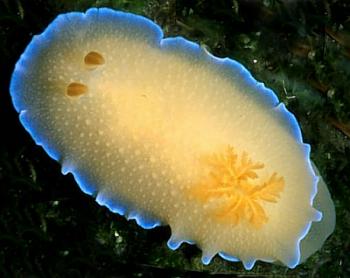
Doriopsilla spaldingi
Valdes & Behrens, 1998
Order: NUDIBRANCHIA
Suborder: DORIDINA
Superfamily: EUDORIDOIDEA
Family: Dendrodorididae
DISTRIBUTION
California
PHOTO
La Jolla Canyon, San Diego, California in about 80 ft. of water in the El nino summer of 1998. Photo: Mike Miller.
It grows to at least 85mm long. See Mike Miller's Slug Site at http://siolibrary.ucsd.edu/slugsite/nudwk134.htm for further information.
See messages and photos below.
Reference:
• Valdes, A. & Behrens, D.W. (1998) A new species of Doriopsilla (Mollusca, Nudibranchia, Dendrodorididae) from the Pacific Coast of North America. Proceedings of the California Academy of Sciences, 50(13): 307-314.
Rudman, W.B., 2000 (September 17) Doriopsilla spaldingi Valdes & Behrens, 1998. [In] Sea Slug Forum. Australian Museum, Sydney. Available from http://www.seaslugforum.net/find/dorispal
Related messages
Doriopsilla spaldingi from Carmel, California
November 5, 2007
From: Clinton Bauder
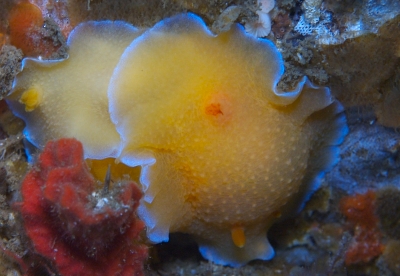
Hi Bill,
Did a nice dive on the Great Pinnacle at Point Lobos State Reserve. Our objective was to survey the nudibranchs at 35 meters along the north wall of hte pinnacle. I had hoped to find Doriopsilla spaldingi and would have been happy seeing one but we found eight. My friend Mark Lloyd got some nice pictures.
Locality: The Great Pinnacle at Point Lobos, 35 meters, California, USA, Pacific, 27 October 2007, Rock wall. Length: 50-90 mm. Photographer: Mark Lloyd.
Clinton
gecko1@apple.com
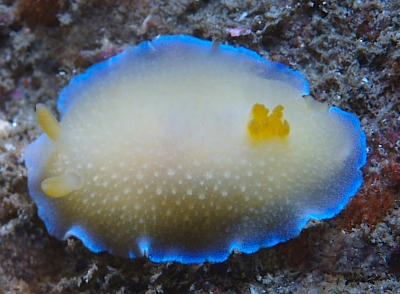
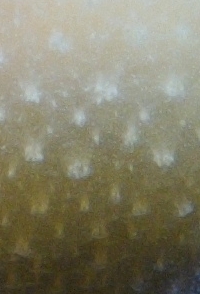
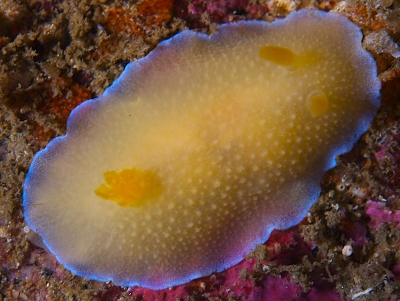
Hi Clinton,
This is great. We have always known the species to be in Carmel, the northernmost documented locality of its geographic range, but this really strengthens that finding. Your specimens match our original description perfectly, with the irridescent blue marginal band distinguishing it immediately from D. albopunctata. The cropped close-up shows the low tubercles on the surface of the notum, a characteristic of species in the genus.
I would like to point out that the depth of this find is consistent with all the documented specimens I am aware of. This is definitely a 30 plus meters species.
Thanks so much for sharing these. This really made my day,
Dave Behrens
Doriopsilla spaldingi from Channel Ids, California
August 3, 2003
From: Bruce Wight
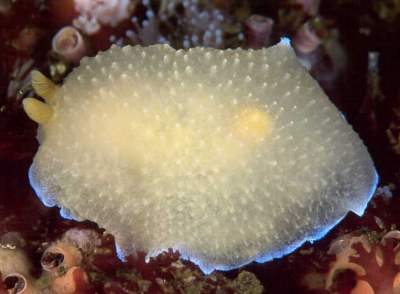
Dear Bill,
Johanna and I saw lots of great natural behavior on last weekends dive trip out to San Miguel Island [Channel Islands National Park, California - July 2003]. The ocean was flat and calm but the water was a cool 53 degrees F at depth. Here is one of a series of messages I am sending to the Forum showing some images I took during the two day trip.
Dave Behren's has identified this species as Doriopsilla spaldingi. It has a very distinctive neon blue line around it, and was found at about 100' [30m] so I didn't have time to hang around for the gills to be displayed. Dave was quite excited by this find as this species was described just a couple of years ago by him and Angel Valdes from 100 ft in La Jolla Canyon. So this is an important extension to its known geographic range .
As always, thanks for your help and hope you enjoy the images,
Bruce Wight
bwproductions@earthlink.net
Wight, B, 2003 (Aug 3) Doriopsilla spaldingi from Channel Ids, California. [Message in] Sea Slug Forum. Australian Museum, Sydney. Available from http://www.seaslugforum.net/find/10655Dear Bruce,
It is an interesting discovery
Best wishes,
Bill.
Doriopsilla spaldingi
September 20, 2000
From: Angel Valdés

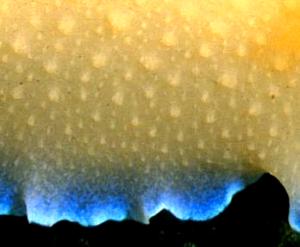
Dear Bill,
Following on Clinton's message I enclose here a picture of Doriopsilla spaldingi. It was taken by Mike Miller in the La Jolla Canyon, San Diego, California in about 80 ft. of water in the El nino summer of 1998. This species is very easily to recognize by the iridescent blue band around the mantle margin, and it is probably the most beautiful animal I ever had the opportunity to describe.
All the best,
Angel
avaldes@CalAcademy.org
Valdés, A., 2000 (Sep 20) Doriopsilla spaldingi. [Message in] Sea Slug Forum. Australian Museum, Sydney. Available from http://www.seaslugforum.net/find/3043Dear Angel & Mike,
Thanks very much for the great photo. I have also posted a magnified view of a section of the mantle to show the rough and firm (and warty? or tuberculate?) nature of the mantle of species of the genus Doriopsilla. Also have a look at Mike's Slug Site at http://siolibrary.ucsd.edu/slugsite/nudwk134.htm
for a further photo and more information on this species.
Best wishes,
Bill Rudman.
Doriopsilla spaldingi from California
September 18, 2000
From: Clinton Bauder
Hi Bill,
Some poking around on Mike Miller's site allowed me to identify the slug mentioned in my previous message. It is Doriopsilla spaldingi - a deep water critter previously described from San Diego. It's at: http://siolibrary.ucsd.edu/slugsite/nudwk134.htm
Pretty no?
Clinton
gecko1@apple.com
Bauder, C., 2000 (Sep 18) Doriopsilla spaldingi from California. [Message in] Sea Slug Forum. Australian Museum, Sydney. Available from http://www.seaslugforum.net/find/3032Dear Clinton,
Thanks for answering your own question. Looking at Mike's photo, D. spaldingi is indeed a spectacular animal.
Reference: Valdes, A. & Behrens, D.W. (1998) A new species of Doriopsilla (Mollusca, Nudibranchia, Dendrodorididae) from the Pacific Coast of North America. Proceedings of the California Academy of Sciences, 50(13): 307-314.
Best wishes,
Bill Rudman.
Unknown Dorid from Carmel, California
September 17, 2000
From: Clinton Bauder
Hi Bill,
I was doing a Trimix dive today just south of the Pinnacles in Carmel Bay, California. At a depth of 210 feet (64 meters) I encountered a dorid that I don't think I've ever seen before. At first glance it appeared to be just another Anisodoris nobilis or one of the many other "Sea Lemons" we have in California but it didn't look quite right so I took a closer look. As the depth was beyond the rated range of my camera I unfortunately don't have any images of it.
This particular animal was about 75 mm long and bright yellow. It had yellow gills and rhinophores. I vaguely remember the rhinophores as lamellate but I could be mistaken on this point. The dorsum was covered in small tubercles but there were no spots - either light or dark as would be expected in the more common "sea lemons". What made this animal unique to my eye was that the dorsum was edged by a very prominent white line. In some ways it reminded me of a Cadlina luteomarginata but with a reverse color scheme - yellow with a white edge rather than white with a yellow edge.
For what it's worth my dive buddy remebered the edging as having a purple or blueish hue but I suspect that may be an artifact of his HID dive light.
Anybody have any idea what this might have been? Nothing in the Behrens book looks quite right.
Clinton
gecko1@apple.com
Bauder, C., 2000 (Sep 17) Unknown Dorid from Carmel, California. [Message in] Sea Slug Forum. Australian Museum, Sydney. Available from http://www.seaslugforum.net/find/3031Dear Clinton,
I won't even hazard a guess. Let's see what replies we get.
Bill Rudman
